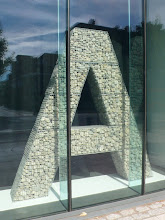Reflection on the last execution of the work led me to believe that there was too much in the way of typographic intervention interfering with the text, that the visual system for the asides, for example, was more visible than the text itself. Conversely, the attempt to identify subdivisions within stuf by using variations of Lucas de Groot's Thesis did not offer enough contrast for the reader to use in navigational terms. A clear idea of a concept sounding great in theory, but not working out in practice. There also seemed to be too much separation between the different strands of content within the book, and at this stage I was only dealing with two, not the four that need to be integrated in the final piece.
So, I decided a systematic approach might help me. Rather than leaving each page open to containing all or any number of types of content I decided to set some kind of parameter in order to give me something to lean, and perhaps push, against. It's funny how we always think it would be great to do anything we want with a piece of design, but in reality this endless choice of options becomes disempowering and we have to define our own parameters in order to progress.


In this case I decided to try two things. Firstly to give the different types of text very different typographic voices. The academic essay is set in Univers condensed, with a hierarchy developed using headings, sub-headings, pull quotes and references in different sizes and weights; the 'Stuff of dreams' is set in Monotype Modern condensed, a serif face with a bit of personality that I think works well with the tone of voice; memories of things are set, caption-like in Univers bold; and finally, conversations are set in ITC Century codensed italic with a subtle weight change indicating a change in speaker. Secondly I decided to have the 'Stuff of dreams' underpin, literally, the whole piece, by running it almost footer-like across the bottom of each spread using a deep enough leading that the asides could be positioned within the lines.

I thought by delineating this space and defining one consistent element on each spread it would enable me to work with the other elements both more easily and more productively. But no... many things about this decision proved to be wrong... scratch that... many things about this decision enabled me to more clearly see how to progress the piece in a more appropriate direction.


By simply running the text in this space I effectively lost editorial control of the content. It became impossible to engage different types of content productively on each page as the 'Stuff of dreams' was unfolding within a mechanistic system that was unrelated to its content and therefore to the narrative. In a very physical sense it also made a small format somehow even smaller. Not only was there less space free to work in with text it also meant images were constrained in their positioning and could never either fully bleed off the page or simply fill the whole of the text fields. This in turn led to much of the typography falling between two stools—neither expressive and related to the content nor creating an interesting well balanced, asymmetric page layout through good use of the grid and judicious use of white space.
At least the textures of the page showed possibiltites with the use of the different typefaces. One small step forward.



However, what this failed attempt also enabled me to do was to reasess the first attempt. Reflecting on them both together I was able to see more clearly some of the potential for using some of the more expressive earlier designs within a slightly more 'controlled' environment. I'm not sure controlled is quite the right word, but what I mean is that I could see possibilities of creating a book that could hang together visually, show a sense of visual connection through its spreads, but one that generated a rhythm that was not monotonous or predictable. In some ways I guess this is like a collection. Each thing/spread has its own individual features, but it evidently belongs to a bigger set.












































